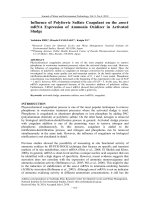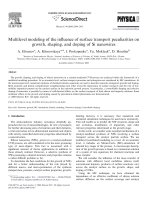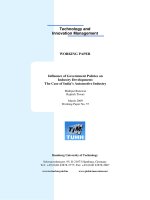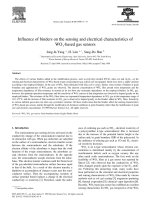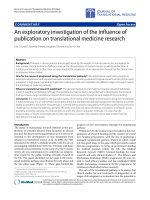- Trang chủ >>
- Khoa Học Tự Nhiên >>
- Vật lý
THE INFLUENCE OF ELECTROMAGNETIC WAVE ON THE RELATIVE MAGNETORESISTANCE IN QUANTUM WELLS WITH PARABOLIC POTENTIAL IN THE PRESENCE OF MAGNETIC FIELD
Bạn đang xem bản rút gọn của tài liệu. Xem và tải ngay bản đầy đủ của tài liệu tại đây (275.02 KB, 6 trang )
Proc. Natl. Conf. Theor. Phys. 37 (2012), pp. 138-143
THE INFLUENCE OF ELECTROMAGNETIC WAVE
ON THE RELATIVE MAGNETORESISTANCE
IN QUANTUM WELLS WITH PARABOLIC POTENTIAL
IN THE PRESENCE OF MAGNETIC FIELD
NGUYEN DINH NAM, DO TUAN LONG, NGUYEN DUC HUY,
NGUYEN QUANG BAU
Department of Physics, Hanoi University of Science, Hanoi, Vietnam
Abstract. The relative magnetoresistance (RMR) in quantum wells with parabolic potential (QWPP)
in the presence of magnetic field under the influence of electromagnetic wave is theoretically studied based on a set of quantum kinetic equations for the electron phonon system. Analyzing the
analytical expressions obtained, we see that the RMR depends on the intensity of electromagnetic
waves , the magnetic field B, the frequency of the radiation and the relaxation time of carrier.
Comparing with the results obtained in case of bulk semiconductors, we see the influence of finitesize effects on the relative magnetoresistance.
I. INTRODUCTION
Nowadays, the study of the low-dimensional systems are increasingly interested [58], in particular, the electrical, magnetic and optical properties of the systems such as :
the absorption of electromagnetic waves, the amplification of confined acoustic phonons
and the Hall effect are of great interest. These results show us that there are some
significant differences from the bulk semiconductor [1-4]. The RMR is also one of them.
In this report, the calculation of the RMR in the QWPP in the presence of magnetic field
under the influence of electromagnetic wave is carried out by using the quantum kinetic
equation method that brings the high accuracy and the high efficiency. Comparing the
results obtained in this case with in the case of the bulk semiconductors, we see some
differences. We also estimate numerical values for a GaAs/GaAsAl quantum well.
II. THE RELATIVE MAGNETORESISTANCE IN QUANTUM WELLS
WITH PARABOLIC POTENTIAL IN THE PRESENCE OF
MAGNETIC FIELD UNDER THE INFLUENCE OF
ELECTROMAGNETIC WAVE
Consider a quantum well with parabolic potential subjected to a crossed electric
−
→
→
−
field E1 = (0, 0, E1 ) and magnetic field B = (0, B, 0). If the confinement potential is
assumed to take the form V(z) = mω02 (z − z0 )2 /2π, then the single-particle wave function
and its eigenenergy are given by :
ψ(r) =
1 ik⊥ r
e
ψ(kx , z),
2π
(1)
THE INFLUENCE OF ELECTROMAGNETIC WAVE ON THE RELATIVE MAGNETORESISTANCE...139
1
kx ωc + eE1 2
1
εN (kx ) = ωp (N + ) +
[ 2 kx2 − (
) ],
(2)
∗
2
2m
ωp
where m and e are the effective mass and charge of conduction electron, respectively,
k⊥ = (kx , ky ) is its wave vector in the (x,y) plan; z0 = ( kx ωc + eE1 )/mωp2 ); ωp2 = ω02 + ωc2 ,
ω0 and ωc are the confinement and the cyclotron frequencies, respectively, and
ψm (z − zo ) = Hm (z − zo ) exp(−(z − zo )2 /2),
(3)
with Hm (z) being the Hermite polynomial of mth order. In the presence of an EMW with
→
−
−
→
electric field vector E = E0 sin Ωt (where E0 and Ω are the amplitude and the frequency
of the EMW, respectively), the Hamiltonian of the electron-acoustic phonon system in the
above mentined QWPP in the second quantization presentation can be written as follows:
εN k x −
H=
e
A(t) a+ aN,Kx +
N,kx
c
ωq b+
q bq +
q
N,kx
CN,N (q)a+
+
a
N ,kx +qx N,kx
(bq + b+
−q ) +
φ(q)a+
a
N,kx +qx N,kx
, (4)
q
N,N ,kx ,q
( b+
and b−
) are the creation and the annihilation operators
→
−
→
q
q
−
→
−
→ −
of electron (phonon), |N, kx > and |N, kx + →
qx > are electron states before and after
→
scattering; ω−
q is the energy of an acoustic phonon; φ(q) is the scalar potential of a
−
→
crossed electric field E1 ; CN,N (q) is the electron-phonon interaction constant.
From the quantum kinetic equation for electron in single scattering time approximation
and the electron distribution function, using the Hamiltonian in the Eq.(4), we find :
where
a+ −
→
N,kx
∂fN,kx
∂t
× [fN
+[fN
eE1
+
,kx +qx
,kx −qx
and a
−
→
N,kx
+ ωc [kx , h]
∂fN,kx
∂ kx
=
+∞
2π
l=−∞
N ,q
(1−fN,kx )(1+Nq )−fN,kx (1−fN
(1−fN,kx )Nq −fN,kx (1−fN
Jl2 (αqx )×
|CN,N (q)|2
,kx −qx
,kx +qx
)Nq ]δ εN (kx +qx )−εN (kx )− ωq −l Ω +
)(1+Nq )]δ εN (kx −qx )−εN (kx )+ ωq −l Ω
.
(5)
→
The frequency of the acoustic phonon is low so we can skip ω−
q in the delta function in
the Eq.(5). Considering the distribution of phonons to be symmetric, in the presence of
the magnetic field, the Eq.(5) has the following form :
∂fN,kx
∂t
+
eE1
+ ωc [kx , h]
∂fN,kx
∂ kx
× (fN
=
+∞
2π
2
Jl2 (αqx )×
|CN,N (q)| (2Nq + 1)
N ,q
,kx +qx
l=−∞
− fN,kx )δ εN (kx + qx ) − εN (kx ) − l Ω . (6)
For simplicity, we limit the problem to case of l = −1, 0, 1. If we mutiply both sides
−
→
of the Eq.6 by (e/m)kx δ(ε − εN (kx )), carry out the summation over N and kx and use
140
NGUYEN DINH NAM, DO TUAN LONG, NGUYEN DUC HUY, NGUYEN QUANG BAU
J02 (αqx )≈ 1 − (αqx )2 /2, we obtain :
R(ε)
+ ωc [h, R(ε)] = Q(ε) + S(ε),
τ (ε)
where
(7)
e
kx fN,kx δ(ε − εN (kx )),
m∗
R(ε) =
(8)
N,kx
S(ε) = −
2πe
4 m∗
|CN,N (q)|2 (2Nq + 1)(αqx )2
N ,q
(fN
,kx +qx
− fN,kx )kx ×
N,kx
× 2δ εN (kx +qx )−εN (kx ) −δ εN (kx +qx )−εN (kx )− Ω −δ εN (kx +qx )−εN (kx )+ Ω ,
(9)
e
m∗
Q(ε) = −
kx (F ,
N,kx
∂fN,kx
∂ kx
)δ(ε − εN (kx )),
(10)
ε−εN (kx )
T
with F = eE1 − εF −
T.
Expressing R(ε) in term of Q(ε), S(ε) after some computation steps, we obtain the expression for conductivity tensor :
σim =
e
τ (εF )
τ (εF )
ao δik +bo b1
δik −ωc τ (εF )εikl hl +ωc2 τ 2 (εF )hi hk +
∗
2
2
m 1 + ωc τ (εF )
1 + ωc2 τ 2 (εF )
+ bo b2
τ (εF − Ω)
δik − ωc τ (εF − Ω)εikl hl + ωc2 τ 2 (εF − Ω)hi hk +
1 + ωc2 τ 2 (εF − Ω)
+ bo b3
τ (εF + Ω)
δik − ωc τ (εF + Ω)εikl hl + ωc2 τ 2 (εF + Ω)hi hk
1 + ωc2 τ 2 (εF + Ω)
where
ao =
N
bo =
N,N
b1 =
4
N,N
eLx
π
eLx ξ 2 kB T e2 Eo2 eE1 ωc
I(N, N ),
4π 2 m∗ ην 2 4 Ω4 ωo2
∆o
(∆o + 3∆1 )θ(∆o )θ(∆1 ) − 2
∆1
−
∆o θ(∆o ),
, (11)
(12)
(13)
∆o
(∆o + 3∆2 )θ(∆o )θ(∆2 )−
∆2
∆o
∆2 − ∆21
(∆o + 3∆3 )θ(∆o )θ(∆3 ) + 2 √o
θ(∆o )θ(∆1 ), (14)
∆3
∆o ∆1
b2 =
N,N
∆21 − ∆24
√
θ(∆4 )θ(∆1 ),
∆4 ∆1
(15)
THE INFLUENCE OF ELECTROMAGNETIC WAVE ON THE RELATIVE MAGNETORESISTANCE...141
b3 =
N,N
∆o =
eE1 ωc
ωo2
2
−
∆21 − ∆25
√
θ(∆5 )θ(∆1 ),
∆5 ∆1
(16)
2m∗ ωp3 (N + 12 ) − e2 E12 − 2m∗ ωp2 εF
2m∗ ωp2
1
εF − ωp (N + ) , (17)
≈
2ω2
2ω2
2
o
o
2m∗ ωp2
1
εF − ωp (N + ) ,
2ω2
2
o
(18)
∆2 =
2m∗ ωp2
1
εF + Ω − ωp (N + ) ,
2ω2
2
o
(19)
∆3 =
2m∗ ωp2
1
εF − Ω − ωp (N + ) ,
2ω2
2
o
(20)
∆4 =
2m∗ ωp2
1
εF − Ω − ωp (N + ) ,
2ω2
2
o
(21)
∆5 =
2m∗ ωp2
1
εF + Ω − ωp (N + ) ,
2ω2
2
o
(22)
∆1 =
The RMR is given by the formula :
∆ρ
σzz (H)σzz (0)
= 2
− 1,
2 (H)
ρ
σzz (H) + σxz
(23)
where σzz and σxz are given by the Eq.(11).
We see that it is easy for the RMR in Eq.(23) to come back to the case of the RMR in the
bulk semiconductor when the confinement frequency (ωo ) reaches to zero. The Eq.(23)
shows the dependence of the RMR on the external fields, including the EMW. In the next
section, we will give a deeper insight into this dependence by carrying out a numerical
evaluation.
III. NUMERICAL RESULTS AND DISCUSSION
In order to clarify the mechanism for the RMR in QWPP in the presence of magnetic
field under the influence of electromagnetic wave, in this section, we will evaluate, plot
and discuss the RMR for a specific quantum well : AlAs/AlGaAs. The parameters used
in the calculations are as follows : εF = 50meV , χ0 = 12.9, χ∞ = 10.9, m = 0.067m0
with m0 is the mass of a free electron. For the sake of simplicity, we also choose N = 0,
N = 1, τ = 10−12 s.
Figure 1 shows the RMR as a function of the electromagnetic wave frequency (EMWF) in
a quantum well. When the EMWF is low enough, the RMR has a sharp drop. It remains
stable when the EMWF reaches a certain value. The RMR is also gets the different values
when the magnetic field changes. These dependences are different from the case of the
RMR in the bulk semiconductor published.
142
NGUYEN DINH NAM, DO TUAN LONG, NGUYEN DUC HUY, NGUYEN QUANG BAU
Fig. 1. The dependence of the RMR on the frequency of laser radiation
IV. CONCLUSIONS
In this paper, we studied the influence of electromagnetic wave on the RMR in the
quantum well with parabolic potential in the presence of the magnetic field. The electronphonon interaction is taken into account at low temperatures, and the electron gas is
nondegenerate. We obtain the analytical expression of the RMR in the quantum well.
We see that the RMR in this case depends on some parameters such as : the intensity of
electromagnetic waves, the magnetic field B, the frequency of the radiation, the relaxation
time of carrier, the temperature and the parameters of the quantum well. We estimate
numerical values and graph for a GaAs/GaAsAl quantum well to see clearly the nonlinear
dependence of the RMR on the electromagnetic wave frequency. Looking at the graph, we
see that the RMR gets the negative values. The more the electromagnetic wave frequency
and the magnetic field increase, the more the RMR decreases. When the electromagnetic
wave frequency reaches a certain value, the RMR will reach the saturation value. There
are some differences from the case of the RMR in the bulk semiconductor. Based on this
idea, we can put forward a capability about changing the functions of low-semiconductor
materials, that may be applied for electronics.
ACKNOWLEDGMENT
This research is completed with financial support from the Vietnam NAFOSTED
(N0 103.01-2011.18)
THE INFLUENCE OF ELECTROMAGNETIC WAVE ON THE RELATIVE MAGNETORESISTANCE...143
REFERENCES
[1]
[2]
[3]
[4]
[5]
[6]
[7]
[8]
[9]
N. Nishiguchi, Phys. Rev, B 52, 5279 (1995).
P. Zhao, Sov. Phys, B bf 49, 13589 (1994).
E. M. Epshtein, Phys. Rev, B 52, 5279 (1995).
M. V. Vyazovskii and V. A. Yakovlev, Sov. Phys, Semicond.11, 809 (1977).
T. C. Phong and N. Q. Bau, J. Korean Phys, Soc. 42, 647 (2003).
N. Q. Bau , L. T. Hung and N. D. Nam, JEWA. 24, 1751 (2010).
N. Q. Bau, H. D. Trien, J. Korean Phys, Soc. 56, 120 (2010).
Yua. S. G, K. W. Kim, M. A. Stroscio, G. J. Iafrate and A. Ballato, J. Korean Phys. 80, 2815 (1996)
Y. M. Meziani, J. Lusakowski, W. Knap, N. Dyakonova, F. Teppe, K. Romanjek, M. Ferrier, R. Clerc,
G. Ghibaudo, F. Boeuf, and T. Skotnicki J.Appl. Phys, 96, 5761 (2004).
Received 30-09-2012.

